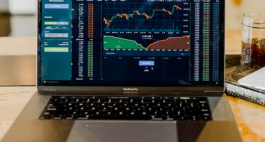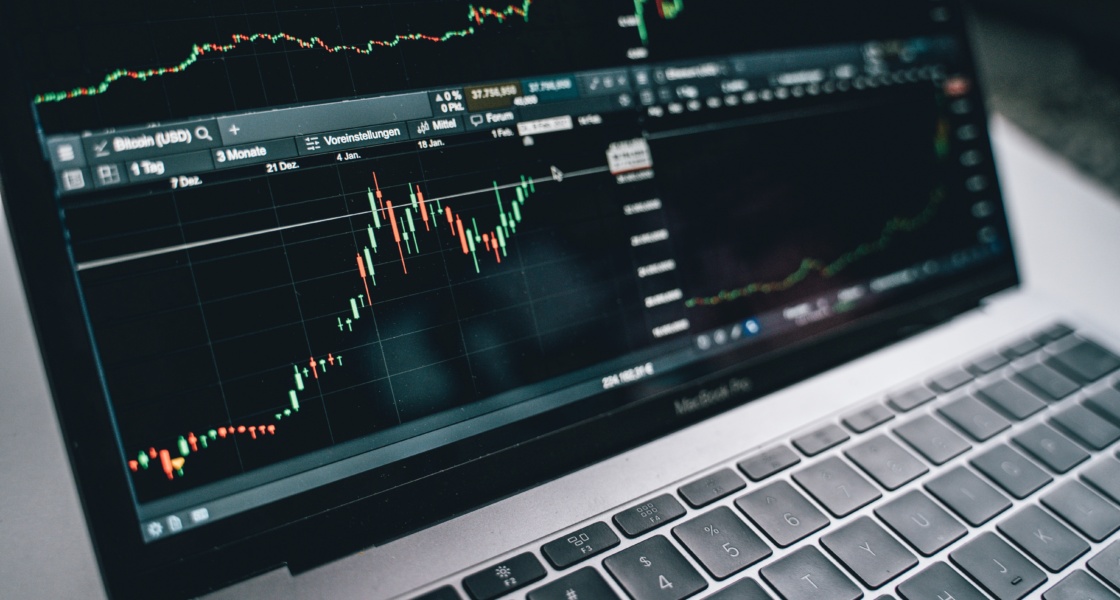
Why should you join our Funded Trader Program?
- Fully funded trading account.
- Big profits 50-50 % profit split.
- Mobile International Trading.
- You’re not liable to losses.
- 10% Drawdown.
- Robust Technology and Deep Institutional Liquidity.

Many beginner traders find day trading overwhelming, but with the right guidance, anybody can start day trading confidently and make profits consistently. In this day trading beginner’s guide, we will help you understand what day trading is, how you can get started, how much money you’ll need to start, and what strategies you may need to win in the market. Keep reading this guide to broaden your day trading knowledge.

Day trading is a method of trading where traders buy and sell assets, like cryptocurrencies, stocks, and currencies, within the same day. Traders ensure all their open positions are closed by the end of the day to avoid exposing their accounts to overnight risks.
Unlike swing traders, who hold onto positions for weeks and months, day traders take advantage of small price movements to make quick profits in the market. This usually requires a good understanding of the market, fast decision-making, and the use of technical analysis to spot short-term trading opportunities.

Many forex traders are drawn to day trading due to a few reasons, which are:
One of the major attractions of day trading is the potential to make quick profits in the financial market. Once you master the intricate concepts of day trading, you will enjoy huge profits. In day trading, trades are usually executed within hours or minutes, allowing day traders to make profits much faster compared to long-term investors.
The good thing with day trading is that it is not only limited to Forex. Traders can also trade in other markets like stocks, commodities, and cryptocurrencies. Each market offers various opportunities for day traders to enter and exit the market multiple times within the day.
Many traders also like day trading because it allows them to be in charge of their financial destiny. They can make their own decisions based on real-time data. This trading style also offers flexibility. One can work from anywhere as long as they have a trading platform, making day trading a perfect option for people looking for independence from a traditional job.
Day trading is also highly attractive to traders who enjoy problem-solving and self-improvement. Each day, the market provides new challenges and opportunities, requiring traders to adapt quickly and sharpen their wits. The dynamic nature of the financial markets offers an adrenaline rush that can be stimulating, engaging, and satisfying to most Forex traders.

Every day trader should be aware of the relevant regulations in day trading to avoid penalties. Being well-informed of the rules in trading will help you manage risk and trade effectively. A few important regulations that you should be aware of include:
PDT is a key regulation in the US set by the FINRA (Financial Industry Regulatory Authority). The Pattern Day Trader rule applies to those traders who execute four or more day trades within five business days, as long as their trades represent over 6% of the total trades during the five-day period.
Traders are also required to maintain a minimum account balance of $25,000 to be classified as pattern day traders. If the account balance falls below that amount, you cannot continue trading until that level is reached.
This is another important rule day traders must understand if they want to day trade effectively. Traders normally use margin accounts, which enable them to borrow money from the broker to improve their buying power. Just like most accounts, margin accounts are also exposed to risks, which is why traders are required to deposit a certain percentage of the security they plan to buy on margin to cover the risk on that particular transaction.
For example, the Federal Reserve’s Regulation T requires traders to make an initial deposit of 50% on margin. Besides that, the PDT rule also expects day traders to have a minimum equity of $25,000 in their brokerage account to continue day trading.
New trading regulations also limit the amount of leverage day traders can trade with, especially in Forex. The Commodity Futures Trading Commission has set a rule that limits leverage for retail Forex traders to 50:1 for major currency pairs and much lower for minor currency pairs.
All day traders are required to verify their identity and financial circumstances under the KYL and AML regulations to start day trading. This regulation is set to prevent money laundering, fraud, and other illegal activities. Traders must give their personal details, financial information, and sometimes proof of income to open an account.
Different countries have their own set rules on how day trading profits should be reported and taxed. For example, in the United States, day trading gains are considered short-term capital gains and are taxed at the same rate as regular income. It is crucial to consult with a tax professional to know how day trading taxation and reporting are made in your country.
Brokers are also subject to trading regulations. They must adhere to the rules set for the sake of transparency, reporting, and protecting client’s funds. In the United States, brokers must be registered with FINRA and SEC to ensure they meet ethical conduct and specific standards for financial stability. All traders must know this information as it will help them choose the correct brokers when they start day trading.
Investor protection schemes are put in place to protect client’s funds in case the brokerage firm fails. The Securities Investor Protection Corporation (SIPC) protects investor’s capital up to $500,000 if the broker goes bankrupt. There’s no requirement that the client reside in or be a citizen of the United States.
To become a professional day trader, you must start by understanding the basics of day trading before you proceed to the technicals. By taking your time to learn the tools, strategies, risk management plan, and psychological discipline needed in day trading you will have created a clearer path for yourself in the financial markets.
When starting, most Forex traders overlook the importance of learning the basic concepts of day trading. This, in turn, makes their trading journey long and overwhelming. As a trader looking forward to winning big in the market, you must understand risk management, the tools a day trader needs, what strategies can be used when day trading, and how to get started.

Just like a carpenter who needs a variety of tools to create polished work, day traders also rely on a set of tools to analyze and execute trades effectively. Having the right tools as a day trader can make all the difference in the world. It allows you to stay informed, manage risks, and get accurate entries in the market. Some of these tools include:
These are software that allows you to view market data in real-time and place trades. With a reliable trading platform, day traders execute trades accurately, view charts, and make significant returns. Some popular trading platforms are MetaTrader 4 (MT4) and MetaTrader 5 (MT5)
Real-time market data allows traders to make informed decisions before executing trades. Most brokers provide real-time data via their trading platform, enabling day traders to benefit big time. Traders can also subscribe to other data services that offer detailed insights.
As a day trader, you must be aware of important announcements and economic events that are about to take place. Announcements such as employment reports, Non-Farm Payrolls, GDP releases, and interest rate decisions usually create a significant impact on price movements. Without an economic calendar, you can be caught off guard, and your entire account can be wiped out within seconds. This makes it a valuable tool for all day traders looking to manage risk effectively.
Before using your money to trade, it is wise to practice on a demo account to test the accuracy of your strategy. A demo account allows day traders to gain confidence in trading on a real account. A demo account will enable you to trade with virtual money, and once you are ready, you can deposit funds into your real account.
Continuous learning is vital in day trading as it will help you improve your win rate. Ensure you have access to quality educational resources to stay updated on new strategies.
Day traders must also use risk management tools as their best allies to avoid risking too much. These tools allow you to protect your trading capital, ensuring you maintain consistency in the financial markets. Position size calculators, stop loss orders, risk-to-reward ratio, and trailing stops are some things day traders must learn to use.
Day traders also need an excellent brokerage account with fast execution, low fees, and a reliable customer support service to enjoy consistent returns.

Successful day traders rely on specific strategies to execute their traders. Here are some of the most common day trading strategies:
This day trading strategy involves opening many small trades throughout the day in an attempt to make profits from tiny price movements. Scalp trades only focus on a few pips normally lasting a few seconds to minutes. The strategy demands fast execution, quick decision-making, and high focus to maximize returns.
Momentum trading is about identifying assets that are moving strongly in one direction. Day traders using this strategy capitalize on the movement until it shows signs of reversing. Technical indicators like Moving Average Convergence Divergence (MACD), Relative Strength Index (RSI), and volume data help momentum trades make better entries.
Whether the market is trending or ranging, day traders can always catch a few pips and make a profit in the market. In a ranging market, day traders buy at deep discount or support level and sell at deep premium/resistance level. This strategy is only for ranging markets that are moving sideways.
News-based trading is another day trading strategy that can be combined with technical analysis. Traders look for trading opportunities created by economic announcements. Traders wait for major news events and act quickly to capitalize on the rapid price movements that are happening.
Breakout trading involves entering positions when the price breaks through a key resistance or support level. When the price breaks a support or resistance level, the market is expected to continue moving in the direction of the breakout. Traders combine this information with volume data to know whether the breakout is false or genuine.
Some day traders also use this strategy to execute trades. A position is opened only when a particular asset is showing signs of trend reversal. The RSI indicator, which shows overbought and oversold markets, allows traders to know whether the market is about to start falling or rising.
Algo or algorithmic trading is the use of computer programs or bots to execute trades. These bots are programmed to execute trades automatically based on price patterns, technical indicators, and statistical models. Algo trading can also be applied to other day trading strategies, such as scalping, reversal, and momentum trading.

Starting day trading shouldn’t be intimidating. All you require is proper education, planning, and preparation. Here is a step-by-step guide on how you should get started;
Get books, courses, and videos and follow market trends to understand what goes on in the financial market. Quality trading videos and courses will help you understand the key trading terms that you will need on your day trading journey.
Day trading can be applied in several financial markets, such as Forex, stocks, futures, options, or cryptocurrencies. Choose one depending on where your interests lie.
When selecting a broker, ensure they are regulated by relevant authorities in your country. Also, choose a broker with reasonable fees and commissions. He should also have a strong customer support team that quickly answers pressing issues and questions.
If you are starting, it is advisable to begin trading on a demo account to avoid losing your real money. A demo account provides you with virtual money that you can use to trade on a real-time market. It also allows you to test your strategies and familiarize yourself with different challenges in the financial market. Lastly, you get to build your confidence without the pressure of losing your hard-earned money.
All day traders need a trading plan. You need to know how much time you’re willing to dedicate to trading, how much money you want to risk per trade, and your entry and exit strategy. You also need to know what times of day you’re interested in taking a trade. Developing a well-defined trading plan will help you navigate the financial market smoothly.
If you want to thrive in the financial market as a day trader, you must use risk management tools. Calculate your risk exposure, use stop-loss orders to prevent losses, and place profit orders to lock in profits.
As a day trader, you must be willing to continue gathering trading knowledge as much as possible to improve your returns. Follow the news, and get psychology books and courses to improve your trading skills.
Discipline is a must in day trading. To succeed in the long run, you should stick to your trading plan and manage your stress by meditating, exercising, or taking breaks. You must also learn to accept losses. Losses are inevitable in day trading and can discourage you from reaching your full potential. Focus on small, consistent improvements until you reach your goal.
Anybody can make a living by day trading, but the endeavor is not for everyone. As much as it is a lucrative business, not everybody is thrilled by the investment idea due to its high-risk nature and the constant pressure it comes with.
However, there are those who have refined their skills, maintained a high level of discipline, and have a certain mindset that allows them to make a living out of day trading. These people include;
Full-time day traders dedicate a lot of time to studying the markets. They treat trading as a full-time job and frequently have to be in the market to earn profits. Full-time traders rely solely on the income they generate from the financial market.
Traders with years of experience already know the ups and downs the market presents. This makes it easy for them to generate huge profits from the market. They are skilled at technical analysis and managing risks and can quickly predict what the market is about to do.
Many prop traders make a living by day trading. This is because prop firms usually provide their traders with huge trading capital, allowing them to maximize their returns. Prop firms also offer other advantages, such as tight spreads, high liquidity, fair profit sharing, etc. These advantages allow prop traders to increase their returns, which are enough to cover their living expenses.
Making a living day trading is achievable for anybody willing to practice consistently and maintain high discipline. Dedication, emotional resilience, and the ability to learn and relearn faster are a few things that will set you apart from the rest.
According to most internet sources, average day traders can make anywhere between $50,000 to $80,000 per year. However, there is no accurate answer to how much day traders can make. This is because individuals’ earnings are majorly affected by factors like leverage, trading capital, risk management, market condition, experience and skill, etc.
Besides, day trading earnings are rarely consistent. Traders can have poor months followed by great ones, which is why it can be hard to give an exact figure of how much money day traders make in a particular period.
Day trading is a lucrative money-making opportunity that can make you successful. But before getting started, you need to have a deep understanding of the market. This investment opportunity comes with substantial risks that may wipe out your trading capital. Therefore, you must have the right mindset, skills, and a proper day trading strategy to avoid losing money.
Many novice traders enter day trading without understanding risk management and other crucial concepts. This, in turn, makes day trading appear as gambling, which is not. As a beginner trader, it is crucial to understand that success in day trading will not come overnight. You require patience, persistence, and willingness to learn from your mistakes.
If you are considering starting day trading, it is also essential to ask yourself whether you can handle the emotional and financial risks associated with trading. If the thought of losing money scares you or causes high stress levels, then day trading might not be suitable for you.
In the world of finance and investment, day trading is a controversial topic that sparks debate among many investors. One reason is that many traders lose money while doing it, which raises financial and ethical concerns. Here are other common controversies about day trading you should know:
Day trading is a very risky endeavor, and most traders lose thousands of dollars, especially as they are starting. Because of this, critics argue that day trading is too unpredictable and it’s impossible for traders to make money consistently day trading. This high financial risk can cause financial distress for those who are not yet prepared for the markets.
Day trading can lead to psychological and emotional stress. The fear of losing money and the pressure to make quick decisions while constantly monitoring the markets can cause anxiety, burnout, and even depression. In an article published in Medium by Jerry Williamson, he also says that day trading can be addictive and is a high-stress activity. Due to this, critics say that day trading is unsustainable and unhealthy for many people.
Many online gurus and advertisements promote day trading as a get-rich, quick scheme, making it appear a scam. While this is not the case for most online mentors, it adds to the controversy surrounding the topic.
These online gurus sell expensive software, signals, and courses, which exploit the hopes of beginner traders. This, in turn, contributes to the negative perception of day trading.
This is another considerable day trading controversy mainly associated with practices such as front running, pump and dump schemes, and other manipulative behaviors, which are illegal. Day traders are also often accused of creating unstable market conditions for other investors due to their high-frequency trading. Some say this can be detrimental to the long-term health of the financial market.
Day trading can be profitable if you are willing to learn the ins and outs of the market. Being a consistently profitable day trader demands a lot of mental energy, dedication, and practice. You must have a well-developed strategy, a good risk management plan, and the ability to maintain psychological discipline.
If you are considering day trading, you should be prepared for the challenges ahead. Day trading only gets easier with time, but you must also be willing to invest time in practice and learning.
Day trading statistics 2024 show that only 1% to 20% of day traders make a profit by the end of the day. On the other hand, 97% of day traders have lost money in the past two years. This low day trading success rate is mainly attributed to the high level of market knowledge, discipline, and skill required for day trading.
Statistical data also show that 40% of day traders quit within the first month due to trading losses. The psychological challenges of managing your emotions and stress while making tough decisions in the market are what cause most traders to quit within the first few months of their trading career.
The first rule of day trading is protecting your trading capital. This means risk management should be your priority before anything else. Preserving your capital in day trading is crucial because it allows you to stay in the game for a long time, allowing you to learn, grow your account and develop a better strategy.
It is important to note that losses are part of the game. Therefore, you should be more focused on minimizing losses rather than solely focusing on profits. One way is to use stop-loss orders. Choosing the right size for each trade, avoiding revenge trading, and keeping your emotions in check are other ways to protect your capital.
Financial experts normally advise beginner traders only to invest 1 to 2% of their capital on a single trade. By doing so, you won’t deplete your capital within a short time, and this will allow you to take advantage of other trading opportunities.
Pattern Day traders are investors who engage in frequent day trading activities in a margin account. Normally, four or more day trades within five business days. The number of day trades must represent 6% of the total trade activity in that particular margin account over the same period.
These traders are protected by a regulatory rule known as Pattern Day Trading (PDT). The PDT imposes certain requirements and restrictions that safeguard traders from the high risk of day trading on a margin.
Investors classified as Pattern Day Traders are required to maintain a minimum of $25,000 in their trading account at all times. If your balance falls below $25,000, your broker will restrict you from making other day trades until the balance is restored. This equity can be a combination of eligible securities and cash.
In other words, the PDT rule forces traders to approach day trading cautiously, ensuring they always minimize risks and maintain enough capital in their margin accounts.
There are 252 trading days in a year and this number accounts for weekdays, excluding public holidays and weekends. Trading usually occurs from Monday to Friday. Holidays like Independence Day, New Year’s Day, Christmas, and Thanksgiving are not counted, which explains why the number of trading days are only 252 in a year instead of 365. Sometimes trading days may vary slightly every year depending on how holidays fall within that year.
The income of day traders can vary widely depending on their experience level, market conditions, risk management practices, trading strategy, and the amount of capital used. Because of this, it can be hard to give an exact figure of how much day traders make, but here is a general breakdown:
The $25,000 requirement for day traders is a rule imposed to safeguard traders from the high risks that come with frequent day trading activity on a margin account. Day traders often use margin accounts to trade, which allows them to borrow funds to boost their buying power. This allows them to maximize their returns, but it can also magnify losses.
The $25,000 minimum requirement ensures these traders reduce risk and maintain sufficient capital to continue trading. The PDT rule also requires that Pattern Day Traders maintain a minimum balance of $25,000 in their accounts. This not only stabilizes trading practices but also mitigates excessive financial distress.
Making $1000 in a day is possible, but you need enough skill and experience to see such kinds of returns daily. Here are a few things to consider if you want to make $1000 a day;
Day trading works, but not for everybody. Studies show that only 1% to 20% of day traders make money. These traders possess advanced skills in understanding technical analysis and market dynamics and have a high level of discipline in everything they do.
The majority of traders fail to see consistent profits because they find it difficult to make accurate short-time predictions. However, with time, these traders begin to see improvements after mastering psychology and consistently practicing. So, yes, day trading works, but you must be willing to continuously learn and invest a little bit of your hard-earned money.
Effective risk management is crucial for successful trading. It helps protect your capital, ensuring long-term profitability. One effective risk management strategy top-day traders use is the “3-5-7 Rule.” This rule helps traders determine how much capital to risk on a single trade. Here is how it works;
By following the 3,5,7 approach, day traders can maintain discipline, protect their trading capital, and control their overall exposure in the market.
Just like employed individuals, day traders also pay taxes on their trading profits. However, tax rules may vary for different traders, depending on how the IRS classifies them. If you are a day trader, one of these taxes may apply to you;
Income Tax: This is where your capital gains are taxed as ordinary income. If your gains exceed the Personal Allowance of £12,570 per year, you’ll need to pay income tax in this manner;
45% if your income is above £125,141
40% if it’s between £50,271 to £125,140
20% if it’s between £12,571 to £50,270
National Insurance Contribution: If you are self-employed and earning a profit of over £12,570 in a tax year or you are an employed day trader making above £242 a week, you’ll probably fall under National Insurance tax.
Capital Gains Tax: Day traders may also be subject to Capital gain tax. This applies to all traders. It doesn’t matter whether you are a part-time, full-time, or self-employed day trader. As long as your profits exceed £3,000 in a year, you’ll be liable. Capital Gain Tax is usually classified into two: 10% for the basic rate and 20% for the higher rate.
Day trading is an exciting investment opportunity that anyone can do, but it comes with challenges that require a solid understanding of the market. Traders must sharpen their skills and develop effective strategies, risk management practices, and psychological discipline to make their trading journey smooth.
For beginner day traders, it is crucial to start with a well-researched plan, have sufficient capital, and continuously learn to improve overall returns. Successful day trading basically involves having the right trading tools and having a working strategy that suits your style.
It’s also worth noting that day trading is a risky business. Even though huge profits exist, so do the losses. Therefore, when trading, always remember the first rule of day trading, which is to protect your trading capital. Managing your capital effectively and using proven risk management strategies like the 3,5,7 rule will help you stay in the financial market long enough.
Also, remember that day trading is not a get-rich-quick-scheme. The skill is built over time, which is why you should focus more on consistency and not solely on profits.











